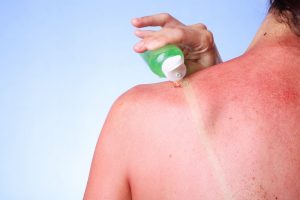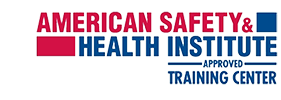Summer is the prime season for outdoor adventures of all kinds, from long hikes and camping to taking a trip to the beach. However, with all these fun activities comes many potential injuries that both children and adults are prone to that might require first aid treatment. Here are some of the most common summertime injuries and what to do if they occur.
Burns
 Beach trips are a summertime favorite, but too long out in the sun can easily result in a sunburn. Fortunately, treating it is simple. Have the sunburnt individual stay in the shade as much as possible and regularly apply aloe to the affected areas. Prevent further sunburn by generously applying sunscreen throughout the day when spending extended periods of time outdoors.
Beach trips are a summertime favorite, but too long out in the sun can easily result in a sunburn. Fortunately, treating it is simple. Have the sunburnt individual stay in the shade as much as possible and regularly apply aloe to the affected areas. Prevent further sunburn by generously applying sunscreen throughout the day when spending extended periods of time outdoors.
Another common summer activity are cookouts, barbeques, and campfires, all of which can result in a painful burn. Even aside from grilling yummy food or roasting marshmallows, accidents can happen. When dealing with a burn, the first step is to quickly cool the burn. Do this by running the affected area under clean, cold water or pressing something cold (but not ice) against it for at least 10 minutes. This will deter swelling and lessen the risk of scarring. Then, loosely bandage the area with a nonstick dressing, such as gauze or a pad, to prevent an infection from occurring. If a burn is more serious or causes extensive blistering and pain, immediately call 911 for medical assistance.
Tick Bites
Outdoor adventures in certain areas like campsites, woods, or parks can result in a tick bite, which is why it is important to wear insect repellent and wear long pants around wooded areas. When dealing with a tick bite, removing the tick from the body as quickly as possible is essential, since an infection could potentially develop if the tick is left untouched for 24 hours. To start, use tweezers to firmly grasp the tick near the head or mouth and gently pull the tick away from the skin. Pulling too hard can cause the body to detach from the head, leaving the head still buried within the skin, so be extremely cautious. Once the tick is removed, thoroughly disinfect the bitten area with soap, water, and an antiseptic.
Be sure to monitor the bitten area, as well as the affected individual themselves, for at least 30 days after removing the tick to ensure that no signs of Lyme disease develop. Watch for a rash in a circular shape around or near the bite, a fever, headaches, chest pain, soreness, and photosensitivity.
Bee Stings
Bee stings are another common summer occurrence that can happen at any time outdoors. To deal with a bee sting, first cautiously remove the stinger. Do this by scraping it with a credit card or finger nail; do not directly pull the stinger, as doing so could accidentally squeeze the venom sac and inject more venom deeper into your skin. Once removed, cleanse the area with soap and water, and apply antibiotic cream and a cool compress to reduce itching and swelling.
If the victim shows one of the following symptoms, or is allergic to bee stings, immediately call 911 or use an epi-pen:
- Hives or a rash
- Wheezing or difficulty breathing
- Dizziness
- Nausea, cramps, or diarrhea
- Fainting
- Swelling around wounded area, face, eyes, lips, tongue, or throat
Heat Exhaustion or Heat Stroke
A long, eventful day out in the sun without water can sometimes result in heat exhaustion, or, if more serious, a heat stroke.
Heat exhaustion occurs when an individual’s core body temperature becomes elevated, due to either dehydration or salt depletion. If the heat exhaustion is caused by dehydration, the individual will typically experience the following symptoms:
- Headache
- Physical weakness
- Extreme thirst
- Fainting
On the other hand, if caused by salt depletion, heat exhaustion victims may experience:
- Dizziness
- Muscle Cramps
- Nausea
- Vomiting
When dealing with heat exhaustion, the goal is to return the victim’s temperature back to normal. To do so, immediately move the person to a cool, shady area, remove any constricting clothing, and give them lots of water. If available, a cold shower or bath might also be necessary.
A more advanced state of heat exhaustion can result in a heat stroke. Generally, a person experiencing a heat stroke will exhibit the same signs as heat exhaustion, along with disorientation, seizures, a loss of consciousness, rapid heartbeat or breathing, and a temperature of over 105° Fahrenheit. Heat strokes can be fatal, so calling 911 is the first, and most important, step to take. While waiting for medical assistance, move the victim to a shaded area and remove any constricting clothing. If ice is available, wrap some in some form of cloth, such as T-shirt or paper towel, and apply to armpits, neck, back, or groin.
Rashes
Poison ivy, poison oak, and other similar plants are pesky. Sometimes, they go completely unnoticed, until an itchy, annoying rash begins to form. These rashes are ultimately caused by a reaction to the oil on the plant, so the goal is to quickly wash it away before it spreads to other parts of the body. Once the rash is detected, thoroughly wash the area with lukewarm, soapy water and pat the area dry. The rash will then be less severe, but will still be present for up to 3 weeks. Afterwards, consistently apply over-the-counter creams or lotions to the affected area to soothe the itching and promote healing.
Be Prepared for Any Summer Emergency With CPR
There are an infinite number of summertime emergencies; some call for CPR. Knowing CPR and effectively performing it can be the key factor in saving a person’s life during an incident, so be prepared for any summer adventure by knowing CPR. Our team at CPR Educators, Inc can easily teach you CPR techniques, as well as a many other life-saving tips, in a fun and engaging environment. Call us now at (919) 639-4848 or register for your class online.



